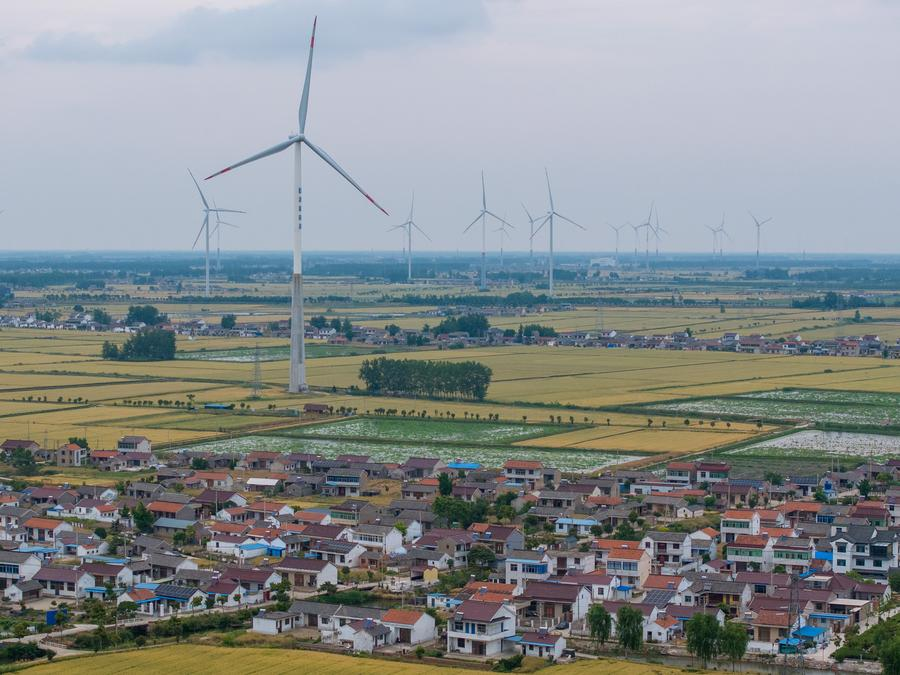An aerial drone photo taken on May 21, 2024, shows a wind power project in Baoying County of Yangzhou, east China's Jiangsu Province. (Xinhua/Li Bo)
BEIJING, May 29 (Xinhua) -- China's steadfast efforts in advancing clean energy and fostering global cooperation have emerged as a crucial drive propelling the world towards a greener future, experts and entrepreneurs said.
"China has emerged as a significant contributor and leader in the global development of clean energy," Yang Lei, vice dean of the Institute of Energy, Peking University, said at a sub-forum of the 14th China Overseas Investment Fair that concluded on Tuesday.
Data from the National Energy Administration has revealed that China contributed over 50 percent of the 510 gigawatts of newly installed renewable energy capacity worldwide in 2023. It also holds a dominant position in the production of photovoltaic components, wind turbines, and batteries.
The rise of China's clean energy industry is a testament to the country's industrial prowess and vividly represents the country's firm pledge to pursue green and low-carbon development.
China has announced that it will peak carbon dioxide emissions by 2030 and achieve carbon neutrality by 2060. This commitment has further spurred the development of clean energy products.
"China's strong capacity to manufacture clean energy products has driven down green transition costs, paving the way for large-scale development of renewable energy globally and the phase-out of fossil fuels," Yang said.
Meanwhile, China is committed to providing affordable Chinese solutions for global energy transformation.
Li Fei, representing PowerChina International Group Limited, explained the company's role in advancing sustainability since its entry into the overseas wind power market in 2011.
Citing one of their landmark projects, the Adama Wind Power Project 1 in Ethiopia, Li said it was the company's first project designed and equipped with Chinese technology, significantly contributing to bringing clean energy to Africa.
As of last December, the company has constructed wind power and photovoltaic power generation projects in over 20 countries, with a combined installed capacity of 50.4 gigawatts, comprising 18.7 gigawatts of wind power and 31.7 gigawatts of photovoltaics.
The company has been exploring the construction of hydrogen energy projects in overseas markets over the past few years, Li said, noting that a wind-to-hydrogen project in Uzbekistan has broken ground, marking the first overseas hydrogen energy initiative undertaken by Chinese companies.
The story of the infrastructure company epitomizes China's endeavors in international cooperation in the clean energy sector. The country has actively engaged in power infrastructure projects in Southeast Asia, South Asia, and Africa. Notable endeavors include the Kaleta hydropower project in Guinea and the Belo Monte power transmission projects in Brazil.
China's wind and photovoltaic power products have also been exported to over 200 countries and regions, helping to reduce electricity generation costs globally.
As a staunch practitioner of enhancing global cooperation, China has partnered with over 100 countries on green energy projects. It has also carried out various forms of cooperation under the framework of green Belt and Road cooperation.
Vladimir Norov, former Secretary-General of the Shanghai Cooperation Organization, highlighted the tangible progress made by Chinese enterprises in energy and electricity storage projects in Uzbekistan, his home country.
Last October, Uzbekistan and China forged an agreement on renewable energy cooperation, a pivotal step towards bolstering energy security and achieving carbon neutrality.
"China is of crucial significance to Central Asia," Norov said, "the demand for clean energy in Central Asia, particularly in Uzbekistan, is substantial. I hope Chinese enterprises will be more active in investing in this region."
Source:
Xinhua News Agency
